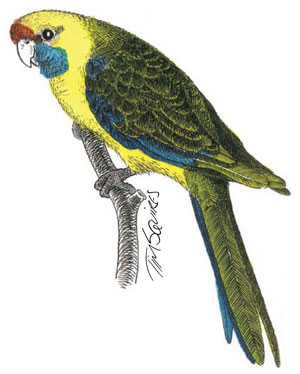
The green rosella gently picking at the seeds of a yellow bottlebrush in my garden carried a stature and grace about it that told of a long life well lived.
I had learned during the summer months that the brighter the colours of a rosella, the older the bird and the bright colour of this old fella – especially the bright yellow on the breast and underbelly and iridescent blue in the wings – certainly suggested he had reached an age that in humans is marked by retirement.
Measured in human terms, in the way we talk of dog years, the life expectancy of a rosella at 15 to 20 years must be the equivalent of between 60 and 65 years.
On a chilly autumn day, watching a green rosella in the autumn of its years can put the life of a person reaching retirement into a different sort of perspective. It’s a good time to contemplate our own lives, and to consider the age-old question of what separates humans from what was termed the “brute creation” in not so distant times.
One thing that certainly separates us and the rest of nature is that birds and animals don’t get to retire, and in turn to contemplate a fundamental change in existence.
The green rosella’s fate, when it is too old to fossick and fly, is to wrap itself in its wings one cold night and slip quietly to that happy hunting ground of native cherry and bottlebrush seed in the sky or, more grimly, to have his slower movements in the trees betray it to the sharp talons of the marauding brown goshawk.
As a “baby-boomer” retiring just over a year ago I was warned by my doctor to prepare myself for the upheaval of leaving the workforce and the social life that went with it, especially the camaraderie and mateship of a lifetime spent as a journalist.
And friends in the medical profession said that retirees often faced depression, feeling they were no longer constructive members of society. They felt like outsiders, isolated, out on a limb. My friends were worried that the energy I devoted to my bird column, and walking on the mountain and in the woods to gather research, might not be enough to keep me occupied. Even though I pointed out that bird-watching was an ideal pursuit for the retired – keeping people fit and alert – it was suggested I join a men’s shed for companionship, or some other group to keep me involved and active.
On that score I’ve been lucky to have discovered the Hobart City Council’s Bushadventures program in recent years and this has provided a vital contact with new faces to go with my birding. In the past year I have studied flowers on the mountain, along with eucalypts, gone looking for owls and followed in the footsteps of bushranger Rocky Whelan.
I have even ventured outside of the adventures billed purely for adults, one night gate-crashing a family event, “going batty” at the Waterworks Reserve in search of bats.
My last outing of autumn was billed a Pinnacle Discovery Walk to study nature in the alpine zone on Mt Wellington. I had needed a lift of spirits on the snow-covered mountain that morning because I was feeling a little down. I had found the bright yellow feathers of the old rosella on the lawn, the old boy no doubt falling victim to a predator during the early morning as the sun came up.